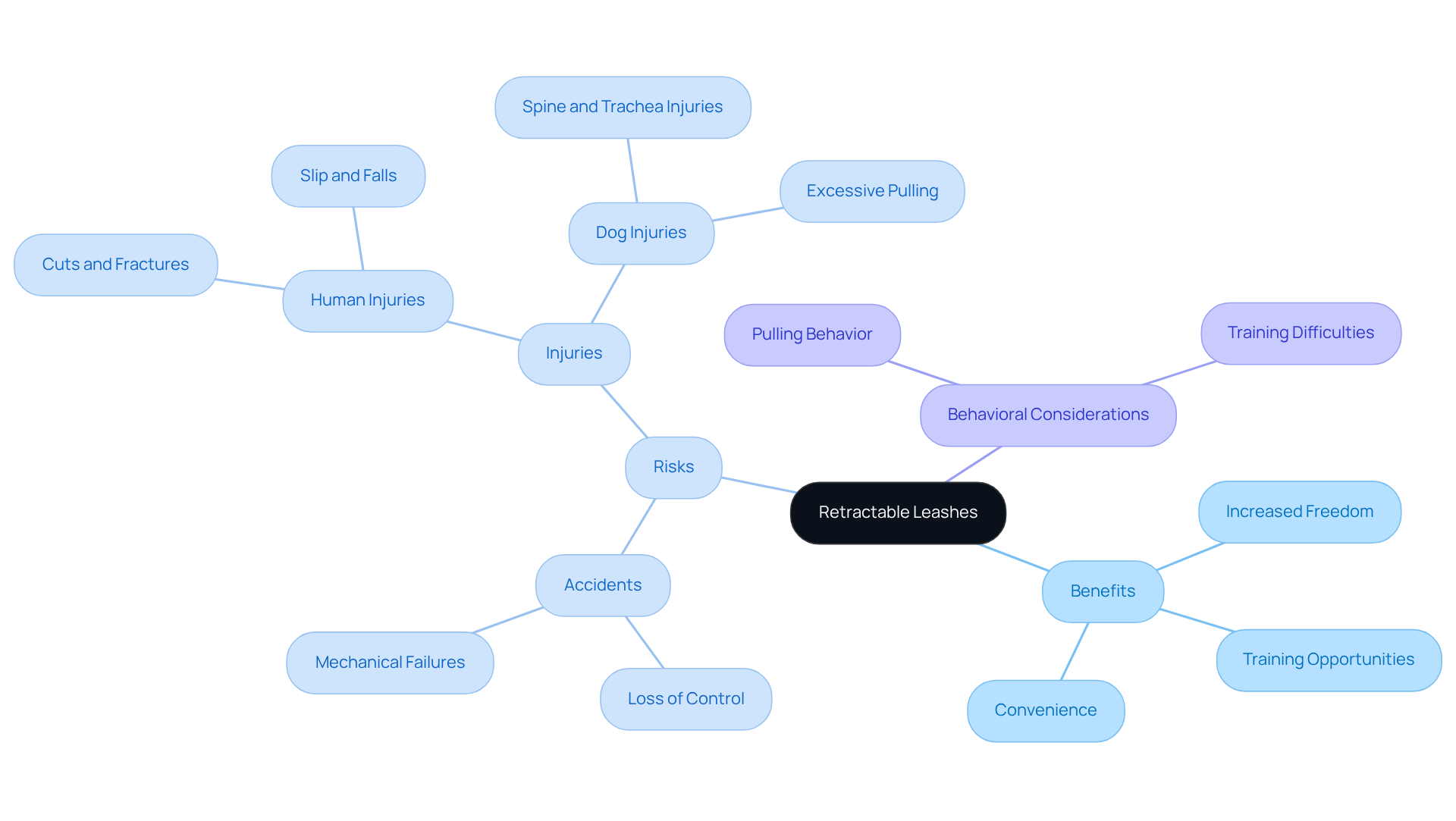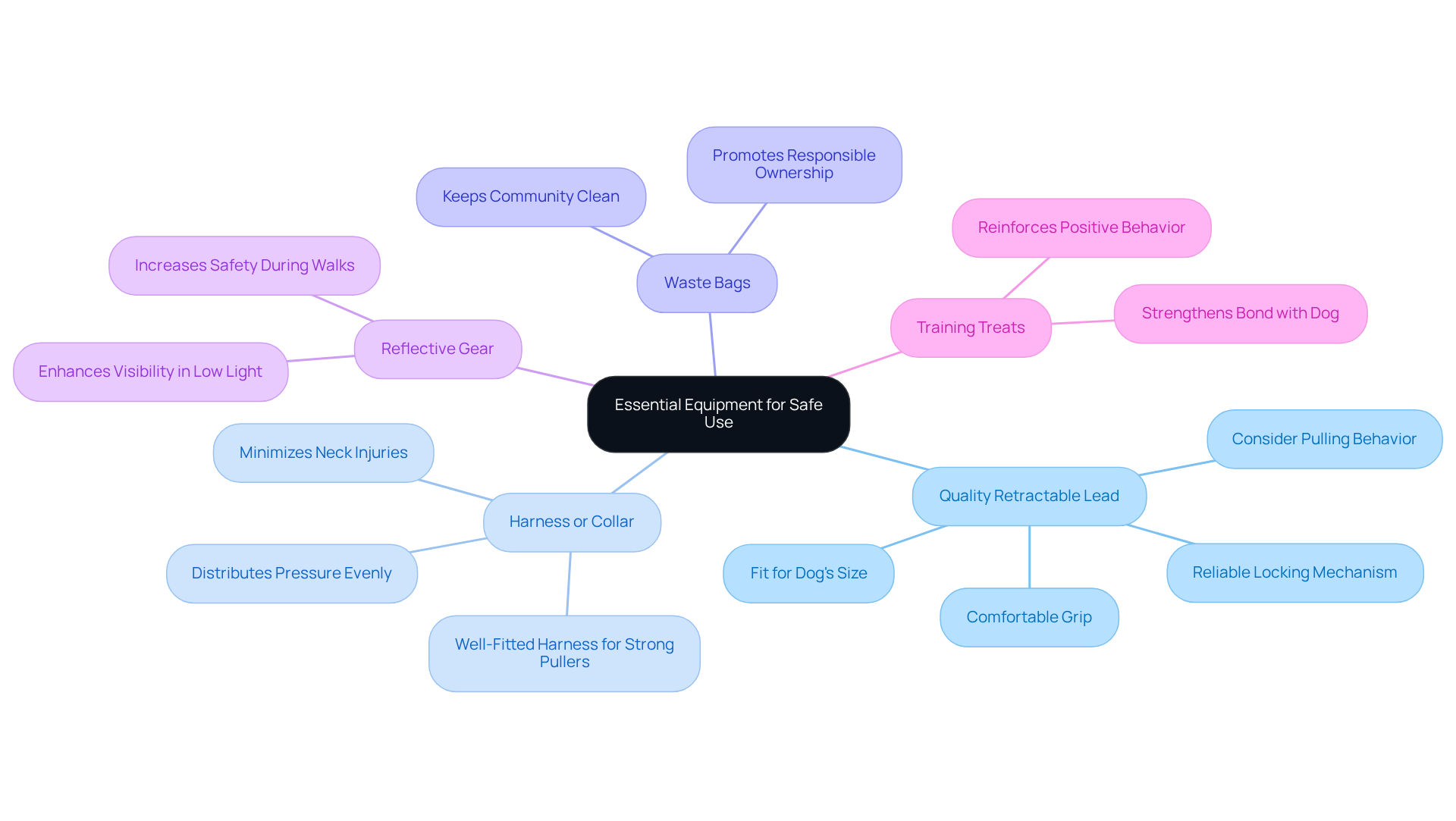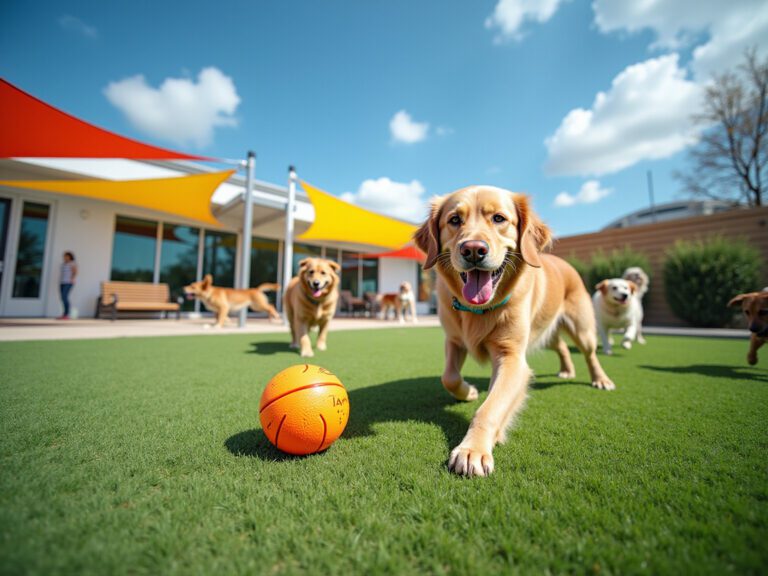Master the Retractable Leash: Essential Techniques for Safe Use
Overview
This article highlights essential techniques for the safe use of retractable leashes, emphasizing the importance of responsible handling to prevent accidents while granting dogs the freedom they deserve. By acknowledging your concerns as a pet owner, it outlines key benefits, potential risks, and necessary equipment, along with practical techniques that promote safety and enjoyment during walks. Our goal is to guide you in creating a positive experience for both you and your furry family members, ensuring that every outing is a joyful adventure.
Introduction
Retractable leashes have truly transformed the way we engage with our beloved dogs, offering a unique blend of freedom and control that many pet owners cherish. As their popularity continues to surge, projections indicate that over 41% of Canadian households will adopt these adjustable restraints by 2025. This exciting trend brings with it a responsibility to understand their proper use, ensuring the safety and happiness of your furry family members.
However, while the allure of extended leashes is undeniable, they also come with inherent risks, such as potential injuries and behavioral challenges. How can we, as caring pet owners, harness the benefits of retractable leashes while prioritizing the well-being of our cherished companions?
Understand Retractable Leashes: Basics and Benefits
Retractable leashes are designed to give your furry family members more freedom to explore their surroundings while still being under your watchful eye. Unlike traditional restraints that are fixed in length, a retractable leash can extend up to 26 feet or more, allowing dogs to roam and discover without being completely unrestrained.
Benefits of Retractable Leashes:
- Increased Freedom: Dogs can enjoy a greater range of movement, especially in open spaces.
- Training Opportunities: They can be a helpful tool for teaching dogs recall and other commands in a controlled setting.
- Convenience: The retractable feature allows for quick adjustments based on the environment, making it easy to draw your dog closer in crowded areas.
However, it’s crucial to recognize that adjustable leads require responsible handling to prevent accidents and ensure safety for both you and your dog. In 2025, it is estimated that over 41% of Canadian households will utilize adjustable restraints, reflecting their growing popularity among pet owners looking to strike a balance between freedom and control.
Despite their advantages, retractable devices have been associated with injuries. Reports from the Consumer Product Safety Commission indicate that these restraints can lead to serious accidents, including cuts and fractures. Dog trainers emphasize the importance of maintaining a firm grip and being aware of the lead’s length to avoid potential injuries.
Moreover, there are behavioral considerations; using adjustable restraints can teach dogs that pulling leads to increased freedom, which may encourage excessive pulling behavior. A cautionary tale is that of Heather Todd, who suffered a severe injury when a flexible cord wrapped around her finger as her dog dashed away, resulting in the loss of part of her index finger.
By understanding the benefits and responsibilities of using a retractable leash, pet owners can create a safer and more enjoyable walking experience for both themselves and their beloved pets.

Gather Essential Equipment for Safe Use
To ensure the safe use of a retractable leash for your furry family members, it’s essential to gather the following key equipment:
-
Quality Retractable Lead: Choose a product that fits your dog’s weight and size. Look for features such as a comfortable grip and a reliable locking mechanism to maintain control. Remember, a retractable leash can sometimes strengthen pulling behaviors in dogs, so it’s important to use it thoughtfully.
-
Harness or Collar: For strong pullers, opt for a well-fitted harness instead of a collar. Harnesses distribute pressure more evenly across your dog’s chest, minimizing the risk of serious neck, tracheal, and spinal injuries that can occur with a collar when using a retractable leash.
-
Waste Bags: Always carry waste bags to clean up after your dog during walks. This simple act promotes responsible pet ownership and keeps our community clean.
-
Reflective Gear: If you find yourself walking in low-light conditions, consider reflective gear for both you and your dog. This enhances visibility and safety, ensuring you both enjoy your time outdoors.
-
Training Treats: Keep treats handy to reinforce positive behavior during walks. This not only makes the experience enjoyable for your dog but also strengthens your bond.
Before heading out, take a moment to ensure that all your equipment is in good condition. This helps prevent accidents and enhances the safety of your walking experience. Additionally, exercise caution when using extendable cords in crowded areas to maintain control and prevent possible injuries. Your thoughtful preparation goes a long way in creating a nurturing environment for your beloved pet.

Follow Proper Techniques for Using a Retractable Leash
To ensure a safe and enjoyable experience for you and your furry family members while using a retractable leash, consider these caring techniques:
- Hold the Handle Firmly: Always maintain a firm grip on the handle to prevent the cord from slipping out of your hand. This simple action can make a big difference in your safety.
- Secure the Restraint When Necessary: Utilize the locking mechanism to maintain the tether at a preferred length, especially in crowded or potentially hazardous situations. Your vigilance helps keep your pet safe.
- Be Aware of Your Surroundings: Keep an eye on your dog and the environment to anticipate any potential hazards, such as other dogs or obstacles. This attentiveness fosters a nurturing environment for your pet.
- Practice Recall Commands: Use treats to reinforce recall commands when your dog is at the end of the lead, encouraging them to return to you. This not only strengthens your bond but also enhances your dog’s safety.
- Avoid Tension: Try to keep the restraint loose to prevent pulling, which can lead to injury for both you and your dog. A relaxed leash promotes a more enjoyable walk.
By practicing these techniques, you can create a nurturing atmosphere that ensures a safer and more enjoyable walking experience with your beloved pet using a retractable leash.

Navigate Common Challenges and Safety Concerns
Using a retractable leash can present unique challenges, but with the right strategies, you can navigate them effectively while ensuring the safety and enjoyment of your furry family members:
- Managing Interruptions: If your dog is easily sidetracked, start training with the lead in a controlled setting. This approach helps your dog learn to focus before you venture into busier areas. Remember, canines typically travel about 20 miles a day at 4 mph, so allowing them some freedom during walks is essential for their well-being.
- Preventing Entanglement: Stay vigilant about your pet’s movements to avoid tangling the leash around objects or other animals. By keeping a close eye on your surroundings, you can significantly reduce the risk of entanglement. Many dog owners experience these challenges, making it crucial to implement preventive strategies for a smoother experience.
- Handling Strong Pullers: For dogs that tend to pull, consider using a front-clip harness. This type of harness discourages pulling behavior and provides better control during walks. As dog trainer Jay Jack noted, the resistance of his extendable cord model is about six ounces, which can assist in managing strong pullers effectively, ensuring a more enjoyable outing for both of you.
- Understanding the Limitations: It’s important to acknowledge that extendable leads are not suitable for all circumstances. They can be troublesome in busy places or when facing aggressive animals, where a typical restraint may provide greater control. As Haley Young highlights, in the right hands, a retractable leash can be a responsible method to enjoy more freedom with our dogs while ensuring their safety.
- Regular Equipment Checks: Regularly inspect your leash and harness for signs of wear and tear. Ensuring that your equipment is in good condition is crucial for safe use, allowing you to focus on enjoying your time together.
By being mindful of these challenges and implementing these strategies, you can enhance both the safety and enjoyment of your walks with your dog. At Adventure Den, our commitment to pet well-being aligns with these practices, ensuring that every outing is a positive experience for both you and your furry friend. So, let’s embark on this journey together, nurturing a loving environment for your beloved companions.
Conclusion
Retractable leashes provide a wonderful balance of freedom and control, allowing your furry family members to explore their surroundings while staying under your watchful eye. However, using these leashes safely and responsibly is crucial to prevent accidents and injuries. By understanding their benefits—like increased freedom and training opportunities—alongside the potential risks, you can make informed decisions about your walking practices that nurture your pet’s well-being.
Throughout this article, we’ve highlighted key considerations, such as:
- Selecting quality equipment
- Employing proper handling techniques
It’s essential to maintain a firm grip on the handle and to implement strategies for managing distractions and preventing entanglement. Each of these techniques contributes to a safer experience for both you and your dog. Regularly checking your equipment and being aware of your surroundings can further enhance the safety of your outings.
Ultimately, the effective use of retractable leashes can turn walks into enjoyable adventures that strengthen the bond between you and your beloved pet. By mastering safe practices and recognizing the leash’s limitations, you can ensure that your furry companion enjoys the freedom they crave while remaining secure. Embracing these techniques not only enriches the walking experience but also promotes a responsible approach to pet ownership, nurturing the well-being of your cherished pets on every outing.
Frequently Asked Questions
What is a retractable leash?
A retractable leash is a type of dog leash that allows for adjustable length, extending up to 26 feet or more, giving dogs more freedom to explore while still being under the owner’s control.
What are the benefits of using a retractable leash?
The benefits include increased freedom for dogs to move in open spaces, opportunities for training recall and commands in a controlled setting, and convenience for adjusting the leash length based on the environment.
What safety considerations should be taken into account when using a retractable leash?
It is important to handle retractable leashes responsibly to prevent accidents. This includes maintaining a firm grip and being aware of the leash’s length to avoid potential injuries.
Are retractable leashes popular among pet owners?
Yes, it is estimated that by 2025, over 41% of Canadian households will use adjustable restraints, indicating their growing popularity among pet owners.
What are some risks associated with retractable leashes?
Retractable leashes have been linked to injuries, including cuts and fractures. There are reports of serious accidents, such as a case where a flexible cord caused a severe injury to a person.
Can using a retractable leash affect a dog’s behavior?
Yes, using adjustable restraints can teach dogs that pulling leads to increased freedom, which may encourage excessive pulling behavior.
What is a cautionary example related to retractable leashes?
A cautionary tale involves Heather Todd, who suffered a severe injury when a flexible cord wrapped around her finger as her dog dashed away, resulting in the loss of part of her index finger.







